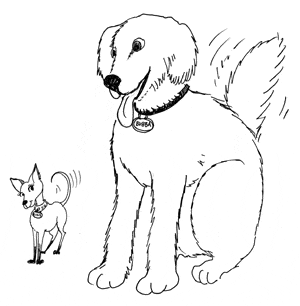Mismatch: Pity the poor puppy mom

DRAWING BY DEBORAH DERR McCLINTOCK
Q. Recently I have noticed a lot of media attention given to artificially inseminated mixed-breed dogs. If a very small dog like a teacup poodle is inseminated with a large breed dog like a St. Bernard, would the mother (1) abort (2) have one live birth puppy (3) have her life endangered? –Pongo
A. Generally not 1 and 3, more likely 2 which may also include a litter of live births, says animal reproduction specialist Dr. Margaret V. Root Kustritz, University of Minnesota small animal theriogenologist (from the Greek therio = beast, gen = birth, ology = study of). "I get this question all the time. Dogs are plenty driven by urges to breed or be bred regardless of their mismatched sizes so artificial insemination might not even be necessary."
Once the female is pregnant, the puppies will grow to the size available to them, so even though it seems counterintuitive, a small female dog can carry pups from a giant breed male dog. Even where there is no size mismatch, says Kustritz, if a female dog has only one pup, it will grow to fill the space, thus becoming larger and more likely to cause dystocia (difficulty whelping) than would pups from a large litter.
Q. The besiegement can be direct or indirect, causing burns, heart attack, brain damage, loss of consciousness, paralysis. Loss of memory and concentration can follow, even personality changes. Aggression and outbursts can ensue, as well as depressed sex drive. Most of the victims' pains are evident within hours or days, though there may be delayed effects. Some 1,000 people per year are affected in the U.S. alone. Bizarrely and seemingly defying all odds, it happened to one hapless guy seven times over a 35-year span, a world record. Can you identify the shocking cause here? –G. Ehrlich
A. Lightning strikes, as detailed in New Scientist magazine. Very rare indeed are those people who gain from a "hit," like the woman who said she acquired an acute sense of smell, or the guy who claimed he became impervious to feeling winter cold ("Weird Harold" to the neighbors).
Q. Imagine (from Encounter with Tiber by Buzz Aldrin and John Barnes): Astronomers detect a signal from Alpha Centauri, 4.3 light-years away, coming in a pattern of high tones (Beeps), low tones (Honks), and silences (probably spacings), in tone-groups of threes: BBB, BBH, BHB, BHH, HBB, HBH, HHB, HHH. Only these groupings occur, arranged in curious long sequences that will require deciphering. Are there any plausible guesses to be made about the aliens' mathematical system and anatomy? –D. Spock
A. Likely the message is in base 8 math, with 3 beep- or-honk choices yielding 8 different arrangements, probably standing for digits 0-7, says Clifford A. Pickover in Wonders of Numbers. "The string of digits in the message could represent pictures or text."
The most common numbering system on Planet Earth is base 10, digits 0-9. But there's no reason to assume aliens would use this. We use 10 because we have 10 fingers, as suggested by "digit" designating both a number and a finger. So might these aliens have a thumb and 3 fingers on each hand, or a thumb and finger on each of 4 arms, or maybe 8 tentacles? "Of course, it's possible their number system has nothing to do with their anatomy, just as the Babylonian base 60 system said nothing about their anatomy."
As for the novel, says Pickover, it turns out the eight groups of honks and beeps represent black-to-white image shadings of eight creatures waving as they board a spacecraft.
Send Strange questions to brothers Bill and Rich at .
#